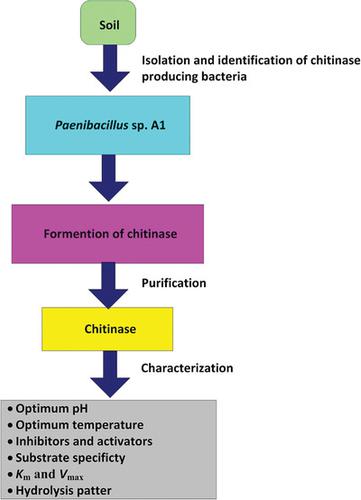当前位置:
X-MOL 学术
›
Biotechnol. Appl. Bioc.
›
论文详情
Our official English website, www.x-mol.net, welcomes your feedback! (Note: you will need to create a separate account there.)
Purification and characterization of chitinase from Paenibacillus sp.
Biotechnology and Applied Biochemistry ( IF 2.8 ) Pub Date : 2020-01-19 , DOI: 10.1002/bab.1889 Jinghe Du 1, 2, 3 , Shan Duan 1, 2 , Jianyin Miao 1, 2 , Miaomiao Zhai 1, 2 , Yong Cao 1, 2
Biotechnology and Applied Biochemistry ( IF 2.8 ) Pub Date : 2020-01-19 , DOI: 10.1002/bab.1889 Jinghe Du 1, 2, 3 , Shan Duan 1, 2 , Jianyin Miao 1, 2 , Miaomiao Zhai 1, 2 , Yong Cao 1, 2
Affiliation

|
The chitinase‐producing bacteria Paenibacillus sp. was isolated from soil samples. The chitinase was purified successively by ammonia sulfate fractional precipitation followed by chromatography on DEAE 52‐cellulose column and then on Sephadex G‐75 column. The chitinase has a molecular weight of ca. 30 kDa as measured by sodium dodecyl sulfate–polyacrylamide gel electrophoresis (SDS‐PAGE) electrophoresis. Its optimum pH is 4.5, and its optimum temperature is 50 °C with colloidal chitin as a substrate. The enzyme is stable below 45 °C and in pH ranges between 4.5 and 5.5. It is activated by glucosamine, glucose, N‐acetylglucosamine, and metal ions including Ca2+, Fe2+, Fe3+, and Ni2+. It is inhibited by SDS, H2O2, ascorbic acid, Cu2+, Mg2+, Ba2+, Sn2+, Cr3+, and K+. With colloidal chitin as substrate, the Km and the Vmax of the chitinase are 4.28 mg/mL and 14.29 μg/(Min·mL), respectively, whereas the end products of the enzymatic hydrolysis are 14.33% monomer and 85.67% dimer of N‐acetylglucosamine. The viscosity of carboxymethyl chitin decreased rapidly at the initial stages when subjected to chitinase hydrolysis, which indicates that the chitinase acts in an endosplitting pattern.
中文翻译:

芽孢杆菌属几丁质酶的纯化和鉴定。
产生几丁质酶的细菌Paenibacillus sp。从土壤样品中分离出来。几丁质酶先后用硫酸铵分级沉淀纯化,然后在DEAE 52-纤维素柱上层析,然后在Sephadex G-75柱上层析。几丁质酶的分子量约为1。通过十二烷基硫酸钠-聚丙烯酰胺凝胶电泳(SDS-PAGE)电泳测得的30 kDa。以胶体几丁质为底物,其最佳pH为4.5,最佳温度为50°C。该酶在45°C以下和pH值介于4.5和5.5之间稳定。它被氨基葡萄糖,葡萄糖,N-乙酰氨基葡萄糖和包括Ca 2 +,Fe 2 +,Fe 3+和Ni 2+的金属离子激活。。它被SDS,H 2 O 2,抗坏血酸,Cu 2 +,Mg 2 +,Ba 2 +,Sn 2 +,Cr 3+和K +抑制。以胶体几丁质为底物,几丁质酶的K m和V max分别为4.28 mg / mL和14.29μg/(Min·mL),而酶促水解的最终产物为14.33%单体和85.67%二聚体。N-乙酰氨基葡萄糖。羧甲基几丁质在进行几丁质酶水解时,其粘度在初始阶段迅速降低,这表明几丁质酶以内分离模式起作用。
更新日期:2020-01-19
中文翻译:

芽孢杆菌属几丁质酶的纯化和鉴定。
产生几丁质酶的细菌Paenibacillus sp。从土壤样品中分离出来。几丁质酶先后用硫酸铵分级沉淀纯化,然后在DEAE 52-纤维素柱上层析,然后在Sephadex G-75柱上层析。几丁质酶的分子量约为1。通过十二烷基硫酸钠-聚丙烯酰胺凝胶电泳(SDS-PAGE)电泳测得的30 kDa。以胶体几丁质为底物,其最佳pH为4.5,最佳温度为50°C。该酶在45°C以下和pH值介于4.5和5.5之间稳定。它被氨基葡萄糖,葡萄糖,N-乙酰氨基葡萄糖和包括Ca 2 +,Fe 2 +,Fe 3+和Ni 2+的金属离子激活。。它被SDS,H 2 O 2,抗坏血酸,Cu 2 +,Mg 2 +,Ba 2 +,Sn 2 +,Cr 3+和K +抑制。以胶体几丁质为底物,几丁质酶的K m和V max分别为4.28 mg / mL和14.29μg/(Min·mL),而酶促水解的最终产物为14.33%单体和85.67%二聚体。N-乙酰氨基葡萄糖。羧甲基几丁质在进行几丁质酶水解时,其粘度在初始阶段迅速降低,这表明几丁质酶以内分离模式起作用。


























 京公网安备 11010802027423号
京公网安备 11010802027423号